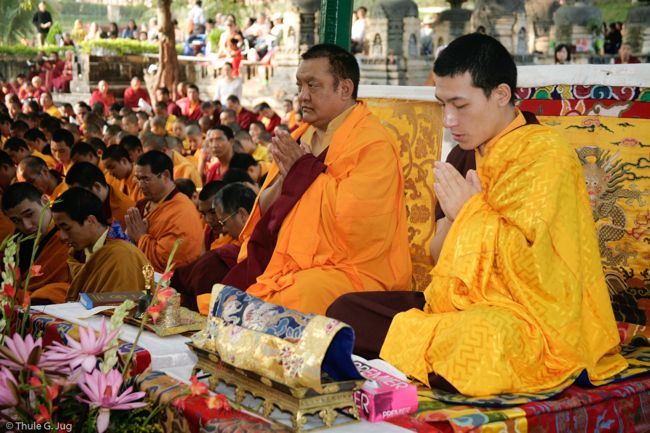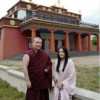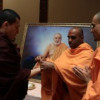The Great Kagyu Mönlam in Bodhgaya
Corresponding to the individual aspirations and inclinations of his students the perfect buddha, Buddha Shakyamuni, gave an immense variety of dharma teachings. Yet all of these serve the purpose to gather the two accumulations and to purify the two types of obscuration.
The foremost among these methods enabling a practitioner to gather the two accumulations is bodhicitta based on great compassion and the virtue accrued thereby. On this basis, the fruition of the enlightened state with its two buddha-kayas is attained and the unsurpassable method to accelerate this attainment is the practise of dedication and aspirations (mon-lam).
A spiritual path comprising the practises of dedication and aspirations is not found in any other religion. It is thus an extraordinary feature of Buddhism: virtue is dedicated towards all beings’ complete enlightenment and aspirations form the link to this unsurpassable fruit.
Ascertaining this practice to be specific to the Mahayana, the noble Nagarjuna once said: “The bodhisattvas’ aspirations, their vast conduct and their dedication were not taught in the shravaka-path”.
As to the difference between dedication and aspirations: dedication requires roots of virtue to be dedicated whereas mere aspirations don’t. The original Sanskrit term for (the Tibetan word) “sngo ba” (which in English translates to “dedication”) is “parinamana”. It literally means “complete change”. The original Sanskrit term for (the Tibetan word) “smon lam” (which in English translates to “aspirations”) is “pranidhana”. It literally means “fully settled”, “one-pointed”, “accumulated”, “accumulate” and “aspiring this for that purpose”.
The practise of dedication and aspirations is extremely important in that they change even a tiny amount of virtue into something extremely vast and inexhaustible. The Buddha taught this for example in the Arya Akshayamati Nirdesha Sutra: “Venerable Shariputra, if, for example, one drop of water falls into a large ocean it will not vanish, but become inexhaustible, never-ending until the all-consuming fire at the end of an aeon. Likewise the roots of virtue fully dedicated to enlightenment will not vanish, but become inexhaustible, never-ending until one’s achievement of the heart of enlightenment”.
In general, whatever type of virtue one practises on the Mahayana path, one sets out with generating great compassion and bodhicitta. One then does the actual practise based on wisdom which does not conceptualize in a perceiver, perceived and perceiving, and finally, one has to seal the virtue by means of dedication and aspirations.
Furthermore, the Buddha taught in the vinaya-sutras that whatever minor or major virtue is practised during the various days commemorating great dharma-occasions such as the Month of Miracles, the Month of Vesakh, the Descent from Heaven etc. at sites associated with the Buddha’s activities such as Bodhgaya, Lumbini etc. is – due to the power of the place and time – multiplied a hundredfold, a thousandfold etc. Therefore, to practice the accumulation of virtue such as making offerings to the Three Jewels with a large monastic sangha-community is said to be especially powerful. In the same sutra it is taught that the monastic sangha symbolizes the Three Jewels, that they are authentic recipients of offerings and the main reference for the accumulation of merit.
Thus it is extremely important to make offerings at special places to the monastic sangha, to seal the accumulations of merit deriving from teaching, debating, meditating, gathering and reciting by means of practising the dedication and the aspirations, and to do so carefully and sincerely.
It is just as Milarepa, the foremost of siddhas, said: “The great meditator who practises in a cave and the benefactor who provides for his living will – due to dependant occurances – attain buddhahood together, and the heart of dependant occurances is dedication.”
Likewise, regarding the practise of aspirations: Shantideva taught in his Shiksasamuccaya that the ten types of countless aspirations of bodhisattvas as taught in the sutras are subsumed in the “Aspirations for Excellent Conduct”. Then there are further great aspiration prayers such as the “Aspirations from Maitreyanatha’s Hagiology” directed towards the attainment of enlightenment once the ten paramitas are fully perfected. Furthermore there are the “Mahamudra-Aspirations” associated with the Vajrayana etc. They all consitute the skillfull path enabling oneself and others to attain enlightenment swiftly. Thus they are held in high esteem by the buddhas and the bodhisattvas.
On April 10th, 2007, I, Trinley Thaye Dorje, who is blessed by carrying the name of the 17th Karmapa, have made these aspirations and wrote this at my residence in Kalimpong so that all participants who are fortunate to take part in the great Kagyü Mönlam at the supreme place Bodhgaya (in India) will generate a pure state of mind.
Original text here.
Other posts which may be of interest :
Tags: aspiration, dedication, Kagyu Monlam Chenmo




 Follow
Follow